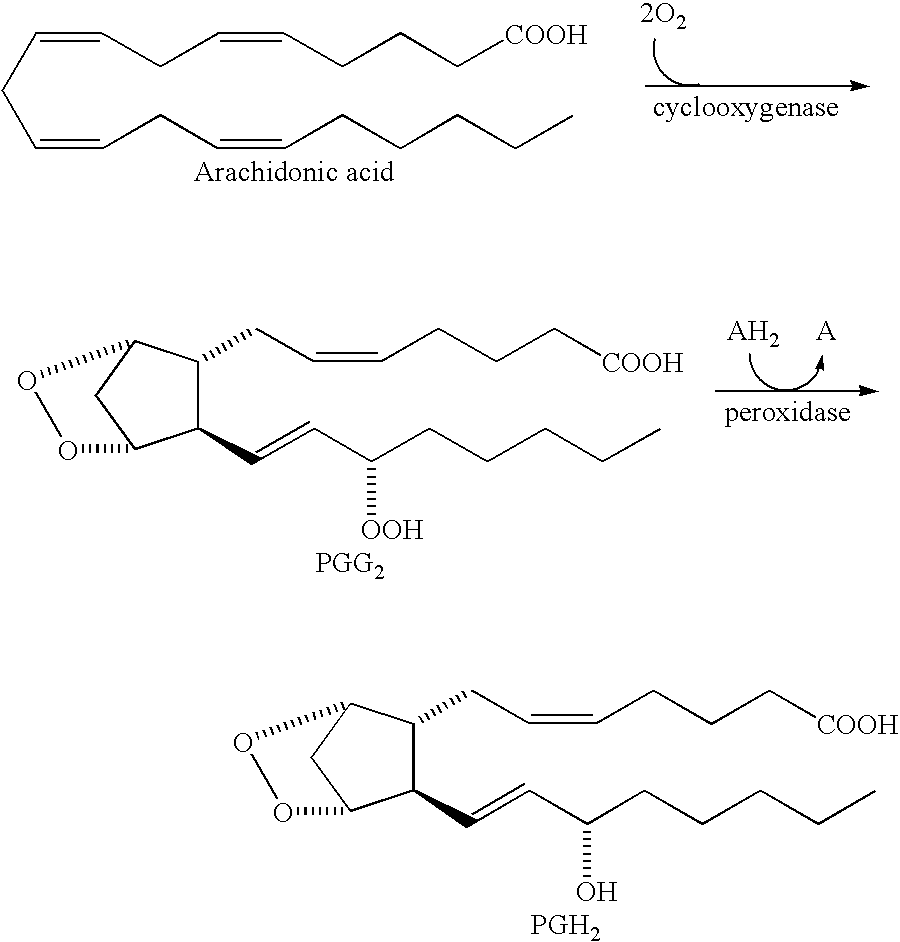Converting cox inhibition compounds that are not COX-2 selective inhibitors to derivatives that are COX-2 selective inhibitors
a technology of selective inhibitors and derivatives, applied in the direction of heterocyclic compound active ingredients, biocide, animal husbandry, etc., can solve the problems of easy hydrolysis of hydroxamates and patents that fail to address cox inhibition
- Summary
- Abstract
- Description
- Claims
- Application Information
AI Technical Summary
Benefits of technology
Problems solved by technology
Method used
Image
Examples
example i
Derivatives with Ester Moiety. The following ester derivatives of indomethacin, designated as compounds 2 through 29, were made.
Procedure for the Esterification of NSAIDs. Method A: To a reaction mixture containing the appropriate NSAID (1 mmol) in 40 mL of the desired alcohol was added 2 drops of concentrated HCl and this mixture was heated under reflux for 2 hours. The reaction mixture was allowed to attain rt and the solvent was concentrated in vacuo. The residue was diluted with water and extracted with Et.sub.2 O (3.times.10 mL). The combined organic solution was washed with 1 N NaOH (2.times.20 mL), water (.about.50 mL), dried (in the presence of MgSO.sub.4), filtered, and concentrated in vacuo. The residue was chromatographed on silica gel and eluted with the appropriate solvent.
Indomethacin methyl ester (compound 2) was obtained as a fluffy white solid (251 mg, 67%) upon chromatography on silica gel (EtOAc:hexanes; 20:80) followed by recrystallization from Et.sub.2 O. mp=94-...
example ii
Derivatives with Amide Moiety.
The following carboxylic acid amide derivatives of indomethacin, designated as compounds 28 through 58, were made. (Note: compounds 28, 29, and 36 through 40 are also disclosed in the above-discussed U.S. Pat. Nos. 3,285,908 and 3,336,194, both to Shen, assignor to Merck & Co., Inc.)
Indomethacin-N-methyl amide (compound 28) was obtained upon chromatography on silica gel (EtOAc:hexanes; 10:90 then 50:50) as a bright yellow solid (271 mg, 79%). mp=187-189.degree. C.; .sup.1 H NMR (CDCl.sub.3) .delta. 7.64-7.67 (dd, 2H, J=6.6 Hz and 1.9 Hz, ArH), 7.47-7.50 (dd, 2H, J=6.7 Hz and 1.9 Hz, ArH), 6.88-6.89 (dd, 1H, J=9.1 Hz and 2.5 Hz, ArH), 6.84-6.87 (d, 1H, J=9.0 Hz, ArH), 6.68-6.72 (dd, 1H, J=9.1 Hz and 2.5 Hz, ArH), 5.22 (bs, 1 H, NH), 3.83 (s, 3H, CH.sub.3), 3.65 (s, 2H, CH.sub.2), 2.75-2.76 (d, 3H, J=4.8 Hz, CH.sub.3), 2.39 (s, 3H, CH.sub.3).
Indomethacin-N-ethan-2-ol amide (compound 29) was obtained upon chromatography on silica gel (EtOAc) as a pale yell...
example iii
Comparison with Sulfonamides of Another Study.
A similar SAR study was previously reported in the above-noted journal article by Li et al. for acidic sulfonamides. (See, the structures drawn above for compounds L-745,337 and NS-398.) Specifically, Li et al. found that replacement of the N-H proton in the NHSO.sub.2 CH.sub.3 moiety of L-745,337 or NS-398 with a methyl group lead to complete loss of inhibitory potency towards either the COX-1 or COX-2 isozyme.
This behaviour may be explained from the recently solved crystal structure of murine COX-2 complexed with NS-398. See, Kurumbail et al., Abstract 197, Eicosanoids and Other Bioactive Lipids in Cancer, Inflammation and Related Diseases, Fifth International Conference, La Jolla, Calif. (17-20 Sep. 1997). Unlike the diarylheterocyclics, NS-398 does not utilize the side pocket even though it contains a sulfonamide group. Instead the sulfonamide binds to Arg106 in a fashion similar to the carboxylic acid-containing NSAIDs.
Although the ...
PUM
| Property | Measurement | Unit |
|---|---|---|
| Weight | aaaaa | aaaaa |
| Weight | aaaaa | aaaaa |
| Weight | aaaaa | aaaaa |
Abstract
Description
Claims
Application Information
 Login to View More
Login to View More - R&D
- Intellectual Property
- Life Sciences
- Materials
- Tech Scout
- Unparalleled Data Quality
- Higher Quality Content
- 60% Fewer Hallucinations
Browse by: Latest US Patents, China's latest patents, Technical Efficacy Thesaurus, Application Domain, Technology Topic, Popular Technical Reports.
© 2025 PatSnap. All rights reserved.Legal|Privacy policy|Modern Slavery Act Transparency Statement|Sitemap|About US| Contact US: help@patsnap.com



